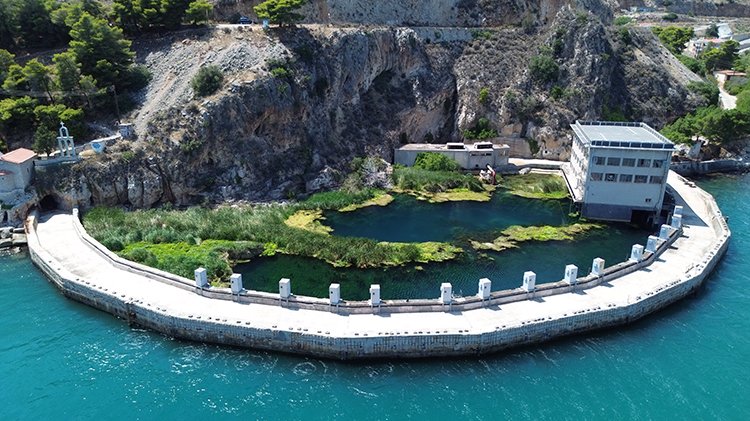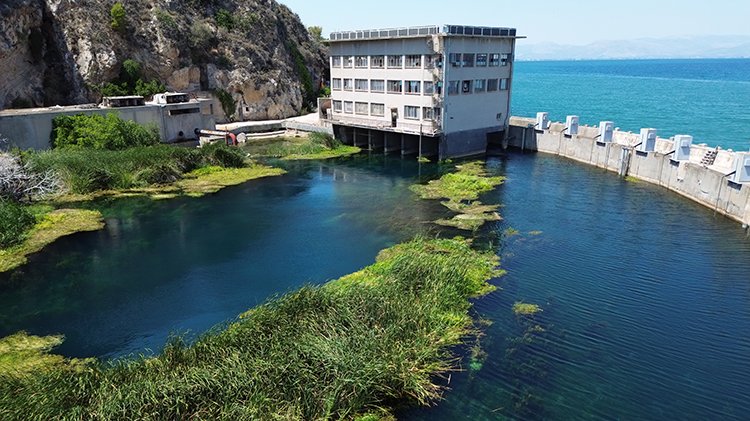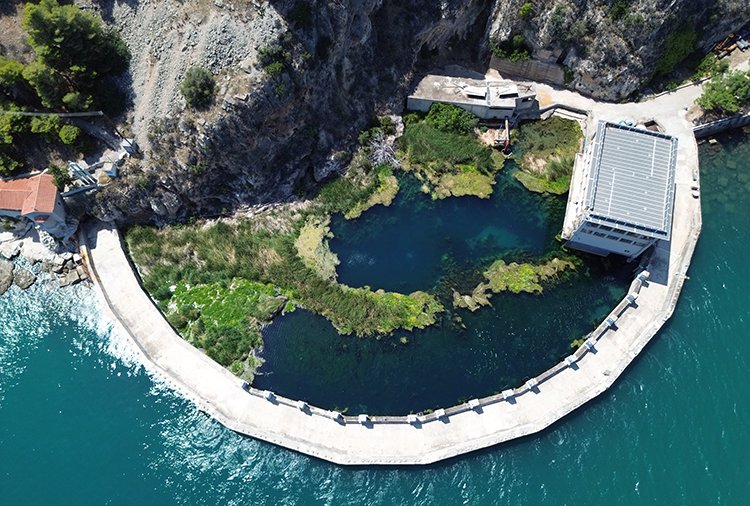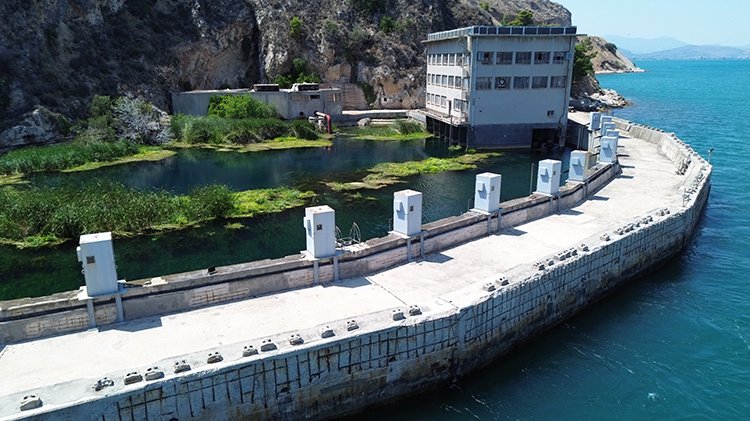The project of the Junta & the unsolved mystery of the Anavalos springs [VIDEO]
- it is springs or "eyes" that gush a large amount of water from the sea. If they gushed out onto land they would be a river
- it is located in the Argolic Gulf on the border of Argolida and Arkadia prefectures
- it is one of the most well-known projects of the Junta of Dictator George Papadopoulos. The project unfortunately did not receive attention later from the Republic
- the pumps supply 30,000 cubic meters of water per hour but the supply of the springs is much greater as most of it is lost to the sea
- no one knows where the water comes from
- even in the worst water shortages, Anavalos does not flinch

Part of the information presented comes from comments on a relevant post on a Facebook page that I manage. Since I come from the nearest village to Anavalos, Kiveri, I am in a position to know the validity of the comments as well as other information.
What is Anavalos
It is springs or "eyes" that gush out from the depths of the sea large quantities of water even in the driest summers. It irrigates most of the Argolic plain and provides water in the summer to Nafplio, but as impressive as it may sound it is only a part of the springs' capabilities as the largest part is lost in the sea.
The project
The Anavalos project was undertaken by german engineers in 1965-67. Later the Junta continued it. One of them, Aristides Dimopoulos Minister of Coordination, invited in 1970 from Germany the student Mr. Staeder who was doing his thesis on Anavalos.
He undertook to find a way to separate the fresh water from the salt water. The German succeeded and isolated the "eyes" by constructing this semicircular structure that is a barrier, essentially fencing off the springs so that seawater does not enter.

The engineering company ARCHIMEDES had undertaken the construction. Archimedes was a port works company and for each project it transported the required tools, namely floating cranes, tugboats, etc. and of course its operators and staff. It also collaborated with local workers or with owners of earthmoving trucks or tools for the land part of the projects and wherever else there was a need.
In Tolo the caissons (cement boxes) were constructed and towed to Anavalos where they were sunk to form the dam. The cement waterproofing injections were done by a Dutchman. His office was in a small cave under the chapel of Agios Georgios. The workers invoked the Saint when the blasts were made with the blasting machines with which the site of the project was formed.
The project was however a gamble for the company due to its complexity. The foreign executives were monitored by the Junta with recording devices placed in their homes.
The dam has water pressure equalization pipes for its protection that look like springs to someone who doesn't know as well as overflow. The only mechanical installation concerns the pumping station and no other systems are needed.
Of course the project was carried out by the Junta and indeed since then no serious maintenance has been carried out but above all there is no serious management of the entire Argolic plain which should be the goal for the health of the peasantry in the prefecture and beyond. Of course the issue of exploitation is not simply to install a pump but to have management.

Anavalos today
It is an oxymoron that while the drilling in Argolis is drying up, Anavalos remains unexploited. It is not only the dam and the pumping of water, it is a much more complicated project. Where will the pumped water go? That is why it is linked to water management policies, something that the Greek state may not be able to manage but may also be indifferent to.
The water has a problem with salinity as seawater is now entering the dam.
During the great drought of 1993, the Mitsotakis Government had discussed the possibility of using the springs of Anavalos to solve the water shortage problem that Athens was facing. Mornos had emptied at that time resulting in the villages that had been covered up being revealed. Finally the Evinos River provided the solution.
Some claim that there is another "eye" with a larger amount of water that comes out about 200 meters into the sea. When there is no wave, a perimeter of water is clearly visible, something like a boundary between fresh - salty or warm - cold water. Although several locals claim this I do not know whether it is true. However during the drought of 1993 I have been told that there was a plan for ships to drop large pipes into the seabed in order to collect water. I do not know if all this is a myth or reality.

Where does the water come from
No one knows and here the mystery begins because the flow of the springs does not keep up with the rainfall and snowfall in the mountains of the Peloponnese nor is it affected by water shortages. The locals say that it comes from the Alps, meaning that it comes from a place with eternal snow. Although it sounds like a figment of the imagination it has a logical basis since it has a large flow that never stops.
In the nearby rivers Lerna, Erasinos and the Eye of Lilis the flow is consistent with the water that falls in the mountains. That is, they follow the seasonal cycle of water with an increase in flow in winter and a decrease or interruption in summer. Also large rivers such as Ladonas have large mountain ranges around them that justify it. In Anavalos the nearest mountain is Mainalo which does not carry so much water and snow. Even Evrotas river which originates from Parnon and Taygetos falls in the summer.
60 years ago paint was thrown on lakes in Arkadia in an attempt to find some connection but nothing came of it in Anavalos.
Some history
The traveller Pausanias in the 2nd century AD in Arkadica mentions: "..there is a large source of fresh water called "Dini" (Vortex) or "Anavalos" into which the residents of Argos threw decorated live horses to Poseidon as a kind of sacrifice, which Poseidon then freed and returned to the shore..".
However it is ambiguous whether he means Anavalos or another smaller eye in Arkadia called "Eye of Lilis" just before Astros.
Agios Georgios chapel
Close to Anavalos there is a chapel of Agios Georgios from 1884, as the inscription mentions, so it predates the work. The choice of Agios Georgios may not be accidental because the Saint killed the dragon and Anavalos is a rather frightening landscape that they may have wanted to appease in this way. It is also common practice to have churches in caves and springs.
My personal experience
In 1998 a friend of mine convinced me on a sailboard trip from Kiveri to Anavalos, not surfing of course, but lying face down and paddling with his hands. So we set off and when Anavalos appeared I realized my mistake as I looked at the steep slopes of the mountain. Although the landscape is wild the view of Anavalos is even more terrifying. As if that weren't enough we had entered the water perimeter dominated by spring water and I put my finger in the water and it froze, that's how low the temperature is, not just cold but freezing.
As if that weren't enough we approached the dam above the flows of the pressure equalization pipes and he was playing with the currents letting them drift the sailboard here and there. At least we weren't in danger for a moment because he's a farmer and therefore strong.













